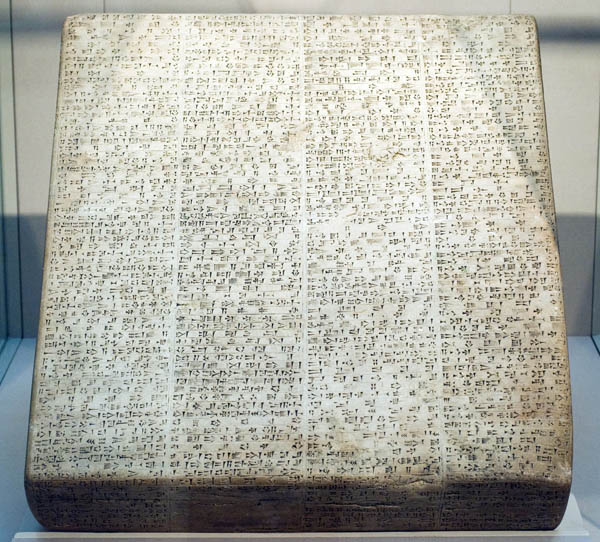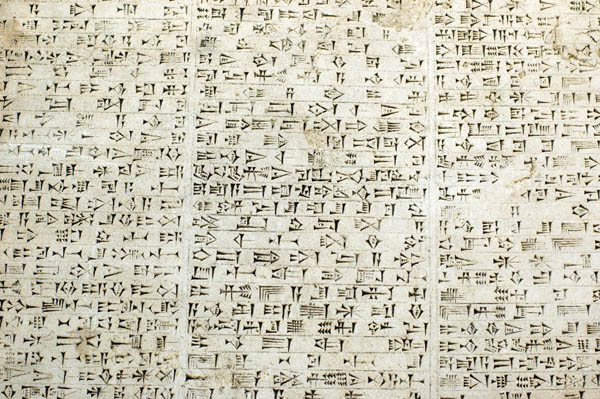I am Nebuchadnezzar King of Babylon the exalted prince, the favourite of the god Marduk, the beloved of the god Nabu, the arbiter and possessor of wisdom who reverences their lordship; untiring governor who is continually careful for the maintenance of the shrines of Babylon and Borsippa, the wise and pious chief son of Nabopolassar King of Babylon.
To my Lord Marduk I made prayers saying Oh eternal prince lord of all being, guide in a straight path the King who though love and who's name you have proclaimed as was pleasing to you. I am the prince, your favourite, the creature of your making. You have created me and entrusted me with dominion of all people. According to your favour which you did give to all people, cause me to love your exulted lordship. Create in my heart the worship of your divinity and grant whatever is pleasing to you because you have made my life.
By your command may the temple which I have built endure for eternity and may I be satisfied with its splendour. In its midst may I gain old age and be blessed with offspring. May I receive a heavy tribute from the people. Form the horizon of heaven to the zenith may I have no enemies and may my dependants live here forever and rule over the people.
Nebuchadrezzar II, more often called Nebuchadnezzar (c 630-562 BC), was a ruler of Babylon in the Chaldean Dynasty, who reigned c. 605 BC-562 BC. He is famous for his monumental building within his capital of Babylon, his role in the Book of Daniel, and his construction of the Hanging Gardens of Babylon and known among Christians and Jews for his conquests of Judah and Jerusalem.
He was traditionally called "Nebuchadrezzar the Great", but his destruction of temples in Jerusalem and the conquest of Judah caused his vilification in the Bible, (Daniel 1:1; Prophesied Jeremiah 25:11). In contemporary Iraq and some other parts of the Middle East, he is glorified as a historic leader. Nebuchadrezzar II, more often called Nebuchadnezzar (c 630-562 BC), was a ruler of Babylon in the Chaldean Dynasty, who reigned c. 605 BC-562 BC. He is famous for his monumental building within his capital of Babylon, his role in the Book of Daniel, and his construction of the Hanging Gardens of Babylon and known among Christians and Jews for his conquests of Judah and Jerusalem.
He was traditionally called "Nebuchadrezzar the Great", but his destruction of temples in Jerusalem and the conquest of Judah caused his vilification in the Bible, (Daniel 1:1; Prophesied Jeremiah 25:11). In contemporary Iraq and some other parts of the Middle East, he is glorified as a historic leader. Nebuchadnezzar was the oldest son and successor of Nabopolassar, who delivered Babylon from its dependence on Assyria and laid Nineveh in ruins. According to Berossus, he married Amytis of Media, the daughter or granddaughter of Cyaxares, king of the Medes, and thus the Median and Babylonian dynasties were united.
Nabopolassar was intent on conquering from the pharaoh Nekau II (Wehemibra, ruled 610-595 BC) (who was still hoping to restore Assyrian power) the western provinces of Syria, and to this end dispatched his son with a powerful army westward. In the ensuing Battle of Carchesmish in 605 BC, the Egyptian army was defeated and driven back, and Syria and Phoenicia were brought under the sway of Babylon. Nabopolassar died in August of that year, and Nebuchadrezzar returned home to Babylon to ascend to the throne. After the defeat of the Cimmerians and Scythians, all of Nebuchadrezzar's expeditions were directed westwards, although a powerful neighbour lay to the North; the cause of this was that a wise political marriage with Amuhia, the daughter of the Median king, had ensured a lasting peace between the two empires.
Nebuchadrezzar engaged in several military campaigns designed to increase Babylonian influence in Syria and Judah. An attempted invasion of Egypt in 601 BC was met with setbacks, however, leading to numerous rebellions among the states of the Levant, including Judah. Nebuchadrezzar soon dealt with these rebellions, capturing Jerusalem in 597 BC deposing King Jehoiakim, then in 587 BC due to rebellion, destroying both the city and the Temple and deporting many of the prominent citizens along with a sizable portion of the Jewish population of Judah to Babylon. These events are described in Ketuvim, a section of Tanakh, the Hebrew Bible and known to non-Jews as the Old Testament. After the destruction of Jerusalem, Nebuchadrezzar engaged in a thirteen year long siege of Tyre (585-572 BC), which ended in a compromise, with the Tyrians accepting Babylonian authority.
It would appear that following the pacification of Tyre, Nebuchadrezzar turned again to Egypt. A clay tablet, now in the British Museum, bears the following inscription referring to his wars: "In the 37th year of Nebuchadrezzar, king of the country of Babylon, he went to Mitzraim (Egypt) to make war. Amasis, king of Egypt, collected [his army], and marched and spread abroad."
Having completed the subjugation of Phoenicia, and inflicted chastisement on Egypt, Nebuchadrezzar now set himself to rebuild and adorn the city of Babylon, and constructed canals, aqueducts, temples and reservoirs.

